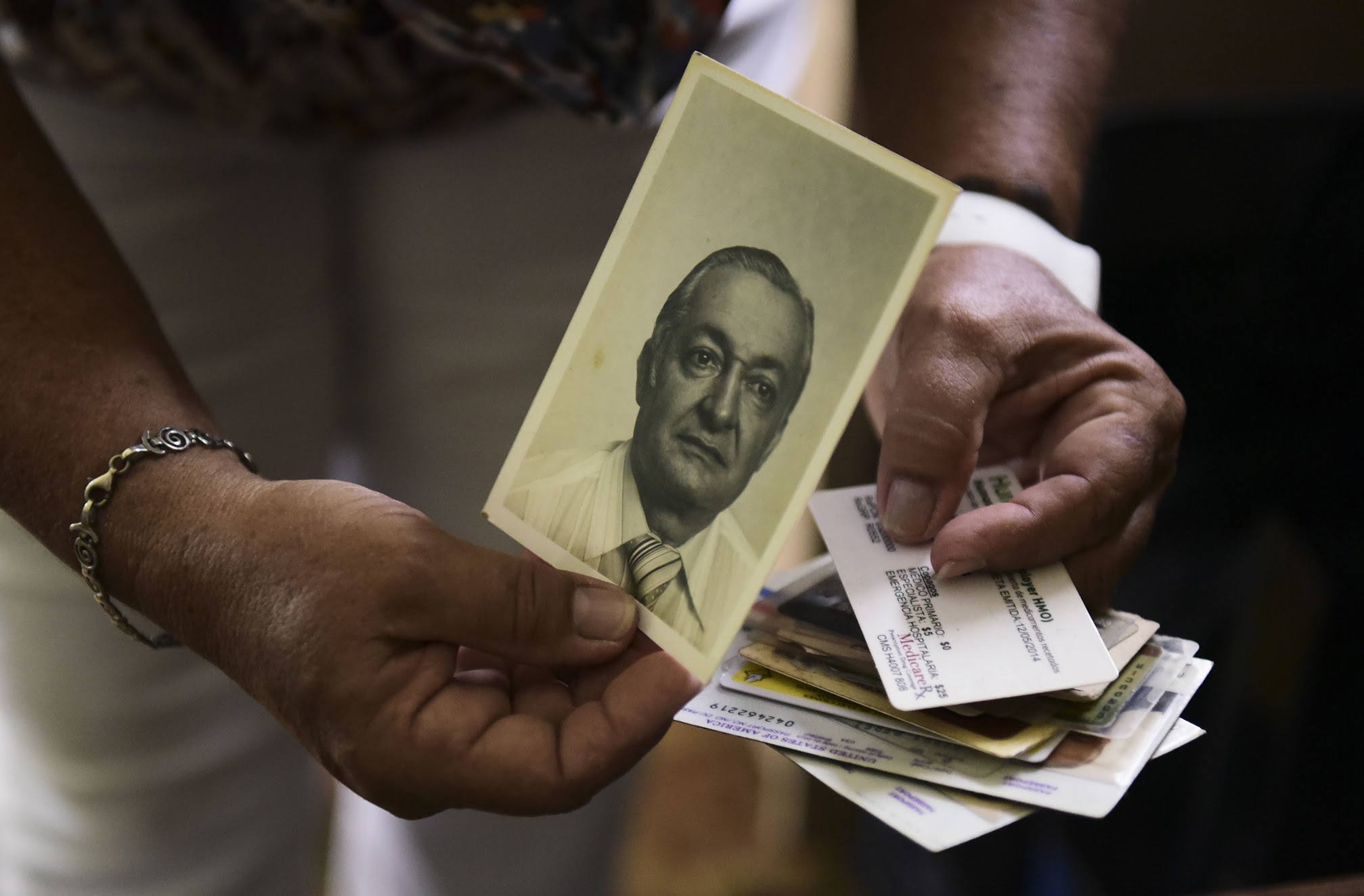

In this June 7, 2018 file photo, Nerybelle Perez holds a picture of her father, World War II veteran Efrain Perez, who died inside an ambulance after being turned away from the largest public hospital when it had no electricity or water, days after Hurricane Maria hit Guaynabo, Puerto Rico. (AP Photo/Carlos Giusti, File)
By Omaya Sosa Pascual, Ana Campoy and Michael Weissenstein | Center for Investigative Journalism, Quartz and the Associated Press
Versión en español aquí. Interactive graphics here.
Four hundred and eighty seven stories of extreme and inhuman suffering, each one with its own name, prove that many of the deaths caused by Hurricane María could have been avoided, while revealing the causes that led to this historic rise in mortality in Puerto Rico.
The latter is evidenced by the only comprehensive record available of the deaths related to the hurricane, documented by a joint investigation of the Center for Investigative Journalism (CPI), Quartz (QZ) and Associated Press (AP). The existing list is that of the Government of Puerto Rico which still includes only 64 deaths.
Meanwhile, U.S. President Donald Trump —who has downplayed the magnitude of the catastrophe since the beginning and glorified his response level— said on Thursday that the estimate of deaths validated by the government of Puerto Rico and produced by George Washington University (GWU) is yet another fabrication from Democrats to make him look bad.
“3000 people did not die in the two hurricanes that hit Puerto Rico. When I left the Island, AFTER the storm had hit, they had anywhere from 6 to 18 deaths. As time went by it did not go up by much. Then, a long time later, they started to report really large numbers, like 3000…This was done by the Democrats in order to make me look as bad as possible when I was successfully raising Billions of Dollars to help rebuild Puerto Rico. If a person died for any reason, like old age, just add them onto the list. Bad politics. I love Puerto Rico!”, he tweeted.
For about four hours, President Trump visited Puerto Rico on October 3, almost two weeks after the storm. According to the mortality statistics of the Puerto Rico Demographic Registry, from September 6 to the time of Trump’s departure, 640 people had died in excess of the average number of deaths during that same period in the previous three years.
One year after Hurricane María, the risk of seeing this tragedy repeat itself is real as systemic failures in access to health services and infrastructure —which caused the majority of deaths— have not been corrected, according to experts interviewed, and also admitted by Puerto Rico Governor Ricardo Rosselló.
“How prepared are we for a hurricane such as María? Well, the truth is that if a hurricane of that nature comes, we will receive the same, a little less or a little bit more devastation. There is no doubt about that,” Gov. Rosselló said when asked by the CPI during a press conference in late August over deaths related to Hurricane María.
The debacle in the three months that followed the hurricane was of such magnitude that it changed the face of death in Puerto Rico, modifying the island’s demographics and main causes of death, yielded the investigation, which also included an analysis of the Demographic Registry’s mortality databases and thousands of death certificates obtained following a lawsuit filed by the CPI to obtain access to that information.
According to the data, the segment in which most deaths were recorded for the entire population, during the three months following the hurricane, was that of young adults of productive age, 30 to 44, with a percentage increase between 23% to 39%, compared to the average of the previous three years. This contrasts to the widely believed, government-backed perception that the elderly people and those with pre-existing medical conditions were the ones who mostly died. Deaths among people over age 70, although more in net numbers, as they usually are, increased between 8% to 10%.
Some of the Those Who Died (The Entire List Is Here)
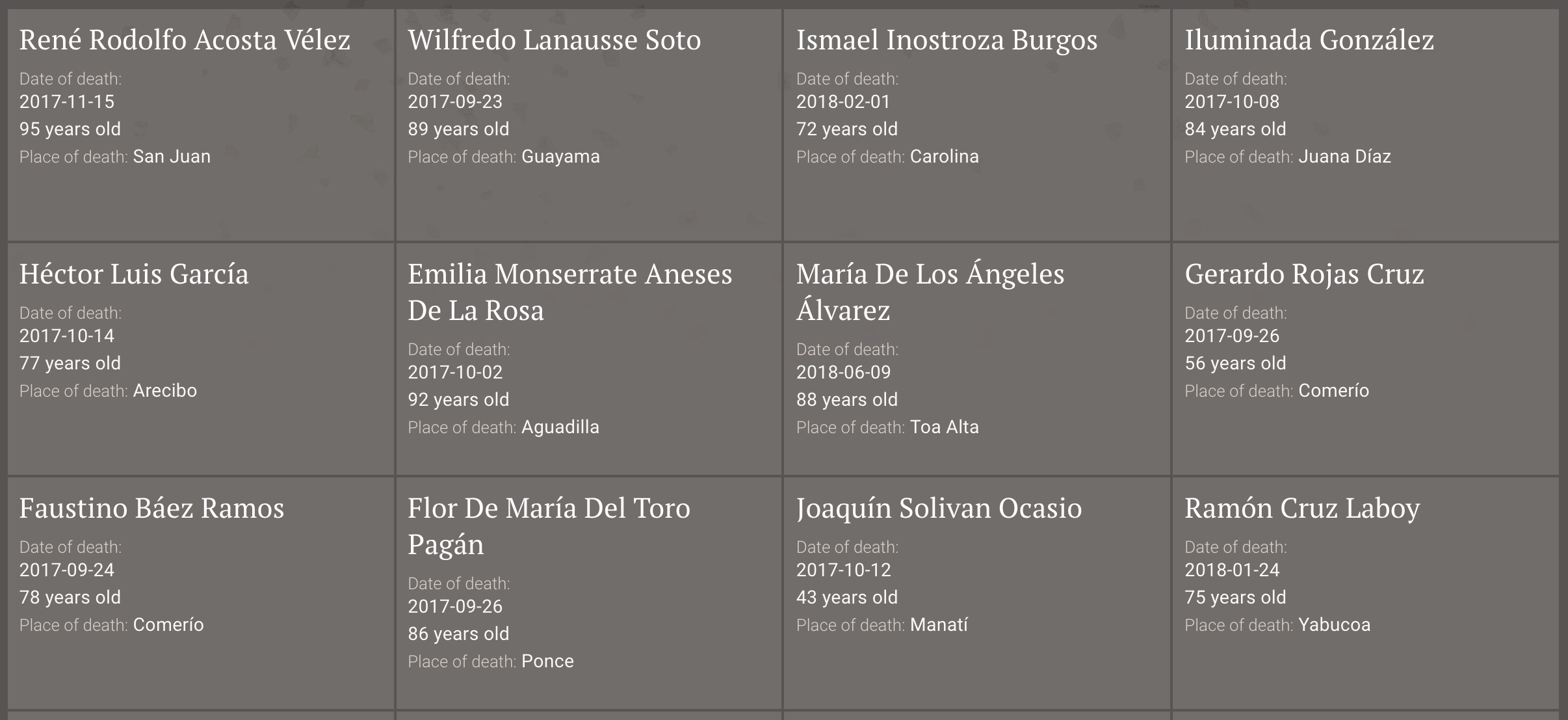

Likewise, sepsis, which has never been among the 10 leading causes of death in Puerto Rico —according to the Centers for Disease Control & Prevention (CDC — was the eighth leading cause of death during that period.
Dozens of stories of victims’ relatives tell how people bedridden and with diseases not related to the hurricane, such as bedsores or even a cavity, ended up dying of sepsis due to the unsafe and unhealthy temperatures and conditions that prevailed in hospitals, as well as the lack of treatment.
Among them is Ramona González Muñoz, who died in her home of bedsores at age 59 after being denied treatment in three hospitals, according to her relatives. The woman, who was bedridden two years ago with a degenerative brain disease, developed bedsores following Hurricane María, when she could not turn on the air conditioning in her room due to lack of power. She was taken twice to hospitals in San Juan, but in both instances she was discharged without being treated because the institutions could not handle the amount of patients.
Desperate, her family tried on October 19 to have her admitted at the USNS Comfort —a U.S. Navy hospital ship brought to Puerto Rico to respond to the emergency— but they found a complicated admission process that required patients were referred through the leading public hospital in Puerto Rico, the Medical Center.
Ramona died the next day at the Ashford Presbyterian Hospital in San Juan.
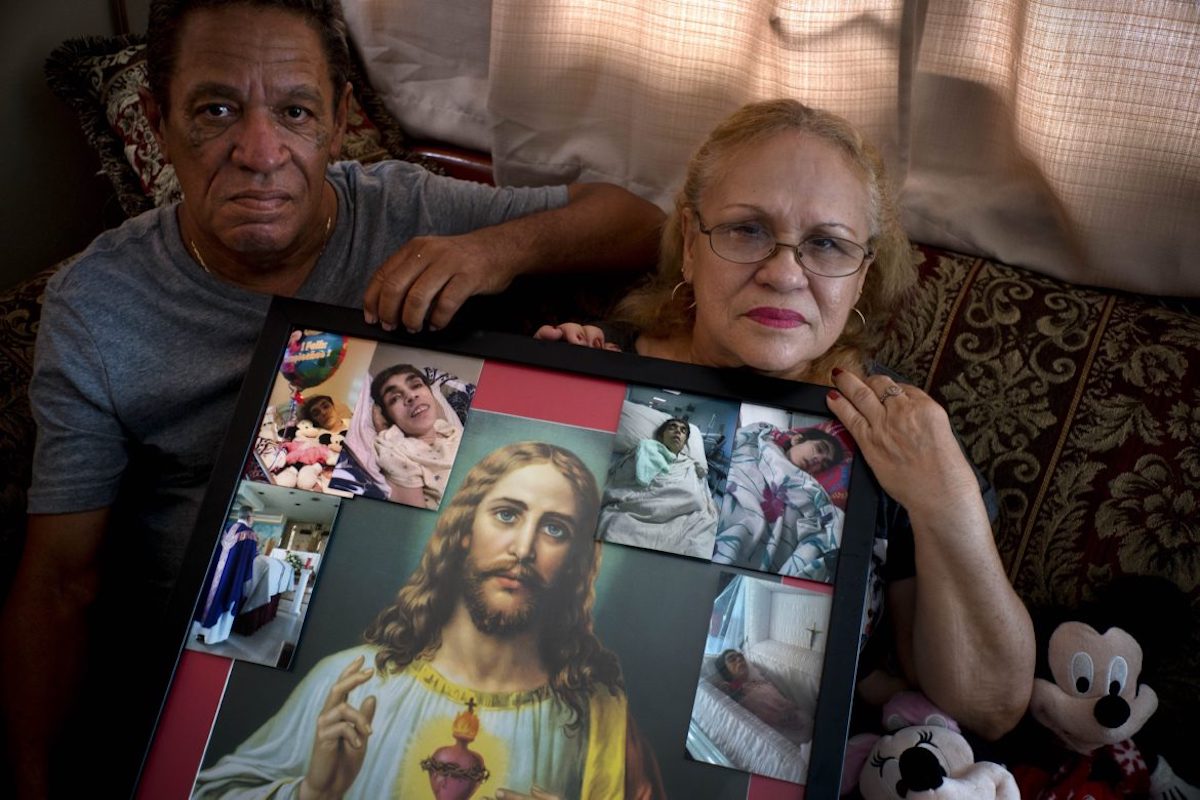

In this September 4, 2018 photo, Maria Gonzalez Munoz, right, and Juan Manuel Gonzalez, pose with an image of Jesus surrounded by photos of her sister Ramona, when she was sick and during her funeral, in San Juan, Puerto Rico. (AP Photo/Ramon Espinosa)
Other causes of death that saw significant increases, from 20% to 45%, were pneumonitis due to solids and liquids, primary hypertension and kidney disease, pneumonia and influenza, and respiratory, Alzheimer’s and heart diseases. Suicides, which are grouped under a category called “other causes,” registered an increase of 43.9%.
Among young adults ages 30 to 44, the causes suggest accidents and heart attacks, according to a review of death certificates and the CPI-QZ-AP registry. A fifth of these deaths are still under investigation.
“These are deaths that could have been avoided,” said Dr. Cruz María Nazario, an epidemiologist and professor at the Medical Sciences Campus of the University of Puerto Rico. She is also one of the researchers of the GWU mortality study.
Dr. Irwin Redlener, director of the National Center for Disaster Preparedness at Columbia University in New York, agreed that the deaths could have been prevented with better preparedness and response to the emergency.
He argued that the response to the disaster by the Puerto Rico and U.S. governments was extremely unsuccessful, although in many cases there were pre-existing conditions that affect mortality and resilience, such as a high level of poverty, lack of access to health services in Puerto Rico and no adequate preparation to face the storm.
Nazario explained the increases in the sepsis and pneumonia & influenza categories are particularly interesting as they do not correspond to diseases or diagnoses that people had before the hurricane, but rather to circumstances that arose due to the total collapse of the health system of Puerto Rico and that, in essence, are preventable.
“These two diseases have served as sentinel death causes that we must continue using in future events because they give us a very quick idea that there is a problem that must be addressed urgently,” she said.
In the case of chronic diseases, such as respiratory and kidney diseases, Nazario emphasized that most patients live if they receive their medications and treatments, which ceased to occur for weeks and months after the storm, victims’ family members told the CPI-QZ-AP alliance.
In dozens of cases, victims’ relatives attribute the death to the lack of dialysis, insulin or oxygen. In total, 300 people in the sample died of chronic diseases, such as diabetes, cancer and Alzheimer’s.
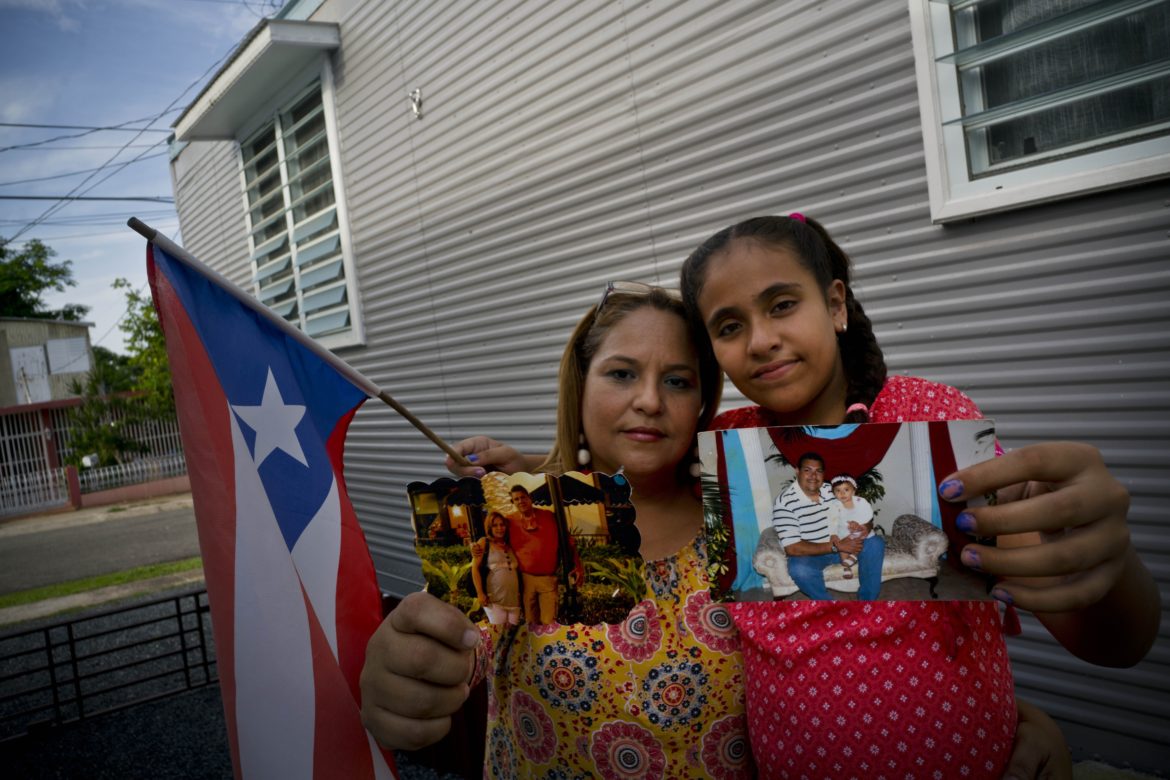

In this September 5, 2018 photo, Lady Diana Torres, left, and her daughter Paula Nicole Lopez, pose with photos of their late husband and father Orlando Lopez Martinez, in Aguadilla, Puerto Rico. Lopez, who died at age 48 on October 10, developed diabetes when he was 11, forcing him to begin dialysis. (AP Photo/Ramon Espinosa)
That was the case of Orlando López Martínez, 48. He has received dialysis treatment since 2014 as a result of diabetes, which he developed at age 11. In the aftermath of María, he lost at least four treatments because the Atlantis center in Aguadilla —where he received dialysis treatment four and a half hours a day, three times a week— was shut down. When it reopened, it did so by rationing services because it lacked enough fuel and water, so López started receiving only two hours of dialysis in each session.
He died on October 10. The official cause of death listed on his death certificate was a heart attack caused by kidney disease. It says nothing about Hurricane María or the lack of adequate treatment.
“In those days after the hurricane, he looked pale and yellow, he looked really bad,” said Lady Diana Torres, the mother of Paola, the 10-year-old daughter López left behind.
Meanwhile Paola is trying to cope with the sudden death of her dad. She did not talk much about it until her school brought in a social worker to talk to children who had lost family members because of the storm.
“The social worker spoke with her and with others who had gone through the same thing. And then everyone talked to her and she cried so much,” her mother recalled, in tears.
The qualitative and detailed information provided by the victims’ relatives to the CPI, qz.com and AP —known as “verbal autopsies”— is of great importance, Nazario said. It is the only source of information that exists about the mechanisms that triggered the clinical causes of death documented by the Demographic Registry and that go to the heart of the relationship between the increase in deaths and the hurricane, as the case of López demonstrates.
Among them are the lack of oxygen, electricity and water in hospitals and treatment clinics such as those for dialysis and chemotherapy; problems with communications and emergency transportation; anxiety and depression; and all kinds of accidents linked to disaster management efforts and deficiencies of basic services such as lack of power in homes and traffic lights on the roads. In the CPI-QZ-AP registry, death reports due to accidents are twice the number of those registered among the general population.
Three weeks after Hurricane, Saúl Pabey Martínez, 27, died in Peñuelas trying to connect a friend’s home to the power grid. The plan was to climb on a pole and make the connection, but Martínez was electrocuted and fell.
“The people [who accompanied him] picked up the ladder and left him there,” said his mother, Doris Milagros Martínez. A policeman found the body.
A week later, Juan Gabriel Valentín Fuentes went to the house of his boss, Ramón Edwin Colón, to cut down a tree that María had knocked down in the patio. One of the branches fell on him and went through his heart.
“We tried to help him but we could not. A digger got him out,” Colón said. Valentín was 32 years old.
On November 5, Kenny Huertas, 30, suffered a fall while helping his neighbors clean up debris. He died that day as a result of the accident.
“That is very valuable because those are possibly the causes of death that the Demographic Registry will never record as related to the hurricane. The value of the sample is precisely in these stories that detail the circumstances that triggered or aggravated the health problem that ended in the clinical death, which is what shows up in the Registry,” said Nazario about the increase recorded in the sample of deaths from accidents.
The systemic failures that sparked the deaths respond to negligent acts by both the Puerto Rico and federal governments, as well as the hospital industry, which at the time of Maria’s landfall, did not meet the standards of planning and preparation to adequately deal with the disaster. All these factors are among the reasons for the high mortality.
In a self-assessment report issued in July 2018, the Federal Emergency Management Agency (FEMA) acknowledged there were failures in its response to Hurricane Maria in Puerto Rico such as inadequate preparation, supplies shortage and coordination problems, as well as assuming tasks that belong to the local government. FEMA Administrator Brock Long did not respond to a request for an interview made by AP.
Before the hurricane, the Puerto Rico government has said it only had emergency plans that were outdated and designed for Category-1 hurricanes, according to the GWU study. Former emergency management directors, however, say that plans for Category 5 hurricanes did exist and were not used. Despite multiple petitions, Puerto Rico’s State Bureau for Emergency & Disaster Management (NMEAD by its Spanish initials) has not provided a copy of the plan that existed by the time María made landfall, nor the revised plan it says it has ready.
Causes of Death


Six months before the hurricane, the commonwealth government consolidated all the emergency response agencies within the newly created Department of Public Security (DSP), led by Secretary Héctor Pesquera. It merged under a single leadership important dependencies that historically have had autonomy, such as the Puerto Rico Police, the Medical Emergency Corps, the Institute of Forensic Sciences (now the Bureau of Forensic Sciences), the State Agency for Emergency & Disaster Management (now NMEAD) and the Fire Department. Puerto Rico’s Health Department was not part of the merger, yet it was also subject to Pesquera’s command during the emergency. Former directors of NMEAD, such as Epifanio Jiménez and Ángel Crespo, have strongly criticized the change, saying that the move affected the government’s response capacity in the face of the crisis.
Nazario argued this was negligent from a public health point of view, changing everything at once without having an alternative plan. “That is the problem with the system failure. The problem was systemic, it is not that it failed here and there, it is that everything failed at once. Why? Because everything was overthrown and deconstructed at the same time,” she said.
NMEAD announced on September 1 that it has a new emergency operational plan ready, but refused to provide a copy of the document on the grounds that it is “confidential.” The emergency plans of all the states devastated by natural disasters during the past decade —Florida, Texas, New York, California and Louisiana— are all public and available on the Internet.
Pesquera, the Rosselló administration official in charge of the government’s failed response to the emergency and underestimation of deaths, said he was willing to sit down for an interview, but after a calendar conflict, he did not schedule for it.
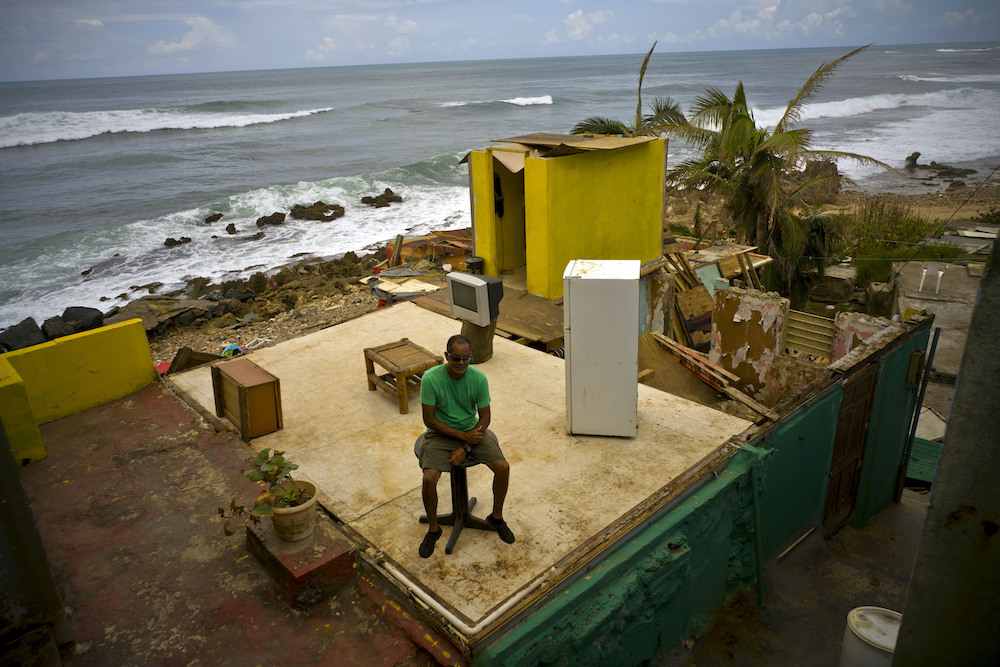

In this October 5, 2017 file photo, Roberto Figueroa Caballero sits in his home destroyed by Hurricane Maria, two weeks after the storm hit La Perla neighborhood on the coast of San Juan, Puerto Rico. (AP Photo/Ramon Espinosa, File)
“I have not seen the plan. I believe that if there is a plan, the first thing that must be done is to disclose it and, above all, to circle it in those agencies that can provide feedback and improve it or correct it. It is not to keep it in a drawer of Pesquera’s office and that he can say there is a plan,” said the epidemiologist.
The Department of Health also did not have a public health emergency response plan to tell health institutions and patients how to respond to a disaster and where to go. Waddy González, a FEMA official in charge of the health component in Puerto Rico, said in an interview that Health Secretary Rafael Rodríguez Mercado has prepared such a plan, but that it has not been made public to the hospital industry and citizens. Rodríguez Mercado refused to be interviewed for this story and did not respond to multiple requests to provide a copy of this plan.
The consequence of dismantling emergency response institutions and lacking adequate response plans was that, after the storm, local and federal agencies did not react with the agility and forcefulness needed to protect citizens, who died by the hundreds, usually for preventable causes.
Most of these deaths occurred in hospitals, which experienced an increase in mortality of 32.3% and were practically inoperative, without electric service, without generators or with deficient ones, and without fuel reserves to operate, according to several testimonies and visits made. The Department of Health, the agency that inspects hospitals and licenses on behalf the Centers for Medicare & Medicaid (CMS), acknowledged that it does not have the resources to timely perform this function and has refused to provide evidence of visits to the facilities after Hurricane Maria. CMS also failed to provide the documents despite multiple requests for this information.
“Maybe in the future we would need a policy that requires that in order to obtain a certification or license to operate [a hospital], you have to be able to mitigate a Category-5 hurricane. For example, you have to have generators, ready, with several days of supplies,” said Alexis Santos, a demographer from the Pennsylvania State University who has extensively analyzed death statistics after Hurricane María. He noted that the data serves to identify failures and create public policy that corrects them and prevents deaths during the next emergency.
Deaths by Age Group
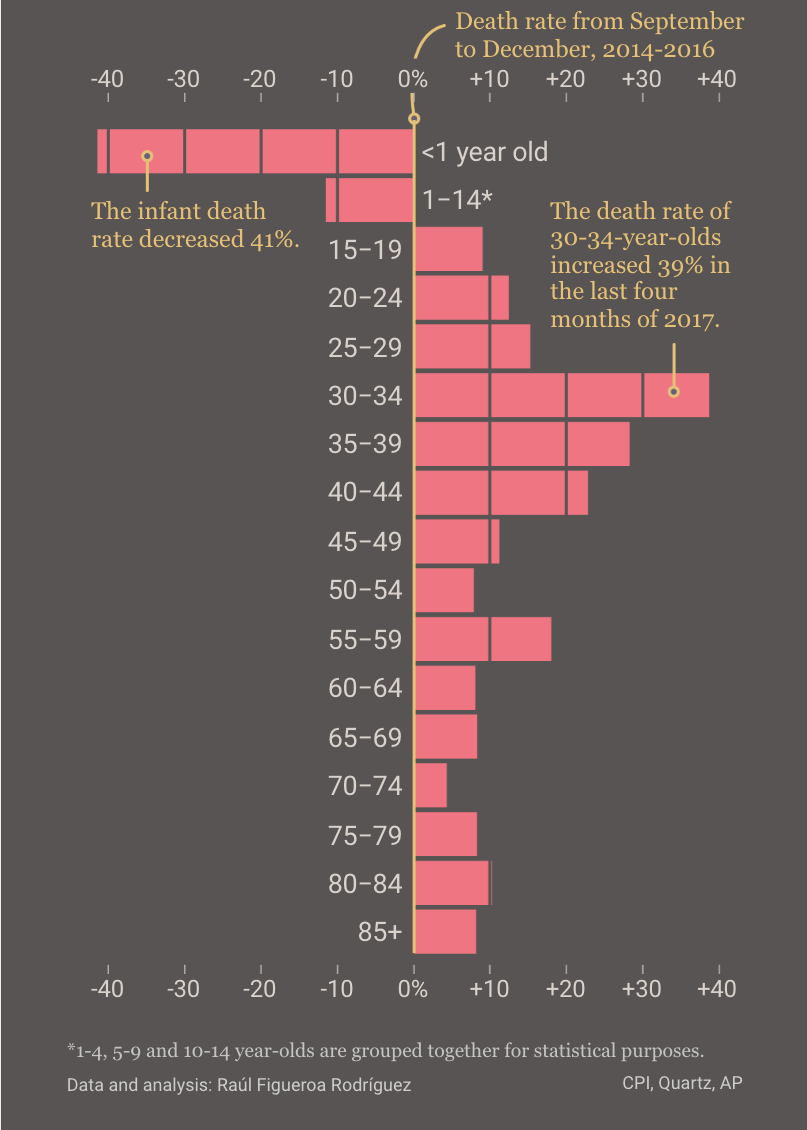

Jaime Plá, executive president of the Puerto Rico Hospital Association, minimized the faults of these health facilities during an interview, as he attributed the increase in deaths to the idea that people with chronic conditions —desperate for the lack of power in their homes, nursing homes or dialysis clinics— practically “came to die in hospitals.” Although the evidence proves that, in effect, all the components of the health system failed, from pharmacies to Puerto Rico’s Medical Center, it also demonstrates fatal flaws in the operation of hospitals.
While he acknowledged that the mistakes made by the Puerto Rico government in preparing and responding to the emergency were enormous, Redlener placed the greatest weight of responsibility on the U.S. government, which having the resources to respond in time and with the strength needed to avoid deaths, failed to do so.
“The Puerto Rico institutions simply did not have the resources and experience that were needed,” he said.
Redlener added that the U.S. government was “negligent” in not sending to Puerto Rico the resources and aid that the scale of the disaster called for. He argued that although the U.S. Army has the ability to reestablish communications, establish temporary electrical systems, rebuild bridges and ensure medical transportation better than any other agency, “it was not activated and deployed on time or at the level that should have been done.”
“This was an inexcusable failure of the U.S. Army, to bring their A game to a major disaster affecting American citizens,” Redlener stressed.
He also recalled that the White House reacted to the hurricane as if it were a minor event and even on October 3, during his visit to Puerto Rico, President Trump congratulated himself on the federal government response.
“I do not think that President Trump cared much [about what happened in Puerto Rico]. I do not know how to put it another way. That was the attitude,” Redlener added.
The expert said that the low number of fatalities reported by the government of Puerto Rico also played a role in the slowness and low level of the federal response.
“The data [on deaths] is important and in many ways,” he said.
“Puerto Rico paid the price for this. If you start by not taking things seriously, nothing works properly,” he further noted.
Redlener added that, now in the recovery phase, he sees the same inconsistency between the real scale of the catastrophe and the resources that are being allocated for reconstruction, as well as the way in which Congress is setting budgetary priorities well below what is required. Congress has approved more than $140 billion in recovery funds for areas hit by natural disasters in 2017. To access them, Puerto Rico has to compete with other affected jurisdictions, including Texas, Florida and California. Federal funds that have been allocated directly to the island, about $16 billion, represent a fraction of what the Rosselló government says it needs. For example, according to his calculations, repairing Puerto Rico’s electricity system would cost $17 billion. So far, Puerto Rico has only secured $2 billion from the federal government for this.
The increase in mortality in Puerto Rico after Hurricane María and the denial of this reality by the government of Puerto Rico were first revealed by the CPI on September 28, 2017. Ever since that publication, the CPI, international media and academics have continued to investigate the situation, producing estimates of excess mortality that greatly exceeded the government’s official number of certified deaths. Death toll estimates range from 800 to 8,500 deaths, the range determined by a Harvard University study published in May, which sparked a massive protest by citizens, many of whom left empty shoes in front of the Capitol in San Juan in honor for their loved ones who died because of the hurricane.
Three weeks before María’s anniversary, the government of Puerto Rico finally adopted the 2,975 figure of the GWU study it commissioned as its “official estimate” of victims. However, this estimate, as well as the other excess mortality figures that have been published to date, are only mathematical computations that do not correspond to real victims of the disaster, do not list the names of the deceased nor talk about the reasons that led to the deaths.
In contrast, the CPI-QZ-AP alliance documented the stories of 487 people who died during the emergency, told by their families and corroborated with interviews, documents and data from the Puerto Rico Demographic Registry. This puts a face to the victims. The deaths listed in the registry verified by the three media outlets would be linked to the hurricane under CDC parameters. These include deaths due to the physical forces of the hurricane, such as landslides or floods; they also take into account those associated with the consequences of the storm, such as the lack of medical services, unhealthy conditions and stress.
During the press conference in which Gov. Rosselló announced the findings of the GWU study, he admitted that his administration failed in its response to the disaster caused by Hurricane María and assumed the responsibility for the “enormous” number of deaths. He also acknowledged that Puerto Rico is not ready to successfully face a hurricane of such magnitude, said that the electrical system is “equally or more vulnerable than it was before the storm,” and estimated that it will take years before being prepared for another event such as María.
Rosselló did not grant the interview requested by the CPI-QZ-AP alliance.
The joint research conducted by some 30 journalists and collaborators that are experts in health, demography and statistics, evaluated several sources of information: the databases of causes of death in Puerto Rico from 2014 to 2018 and 23,000 death certificates, obtained after a CPI lawsuit against the government. It also included a sample of 487 verified cases of deaths related to the hurricane for which relatives of the victims related —through an online form, in person or through telephone interviews— the circumstances in which their loved ones died.
It took Gov. Rosselló three months, at least a dozen investigative reports, two demographic analysis of excess mortality —one from the government itself through the Demographic Registry— and various public expressions of epidemiologists to admit that his mortality figure was wrong. Eight days after María’s landfall, the CPI had already published evidence pointing to hundreds of deaths and that the government’s death toll was wrong. The CPI has asked Gov. Rosselló for several interviews to discuss about the matter since October 2017, but they have not been granted.
The governor ordered on December 21 a recount and in-depth study over the deaths, first to Pesquera, the official who failed and called as false the reports on high mortality, and then to the Public Health School of GWU, which generated the aforementioned estimate of excess mortality on August 28. Gov. Rosselló’s request to these health professionals, however, did not include an analysis of the causes for such high mortality, so the study did not include this vital information. Being an estimate, GWU did not produce a new list of victims either.
When it comes to saving lives, disaster preparedness plans for the short, medium and long term and developed with the input and participation of the communities are key, said Dr. Jennifer Horney, director of the epidemiology program.at University of Delaware. She explained that local knowledge of which population needs oxygen or dialysis, for instance, is fundamental. Dialysis patients are the most vulnerable because they have a tight timeframe: losing an appointment results in serious health consequences, she said.
“Without a pre-disaster recovery plan communities just tend to be sort of doing a lot of things at once and not focusing on where the greatest needs are. There’s going to be a lot of pressure to do a lot of things very quickly. Trying to plan in the immediate aftermath of a disaster is really difficult,” Horney explained.
She further said that the type of care available to people with critical conditions will have a huge impact on their survival and future complications.
“Chronic conditions, which are manageable, can become deadly very quickly without proper care. For example, if a child with asthma can’t access their inhaler, that child’s life is in danger. The lack of appropriate services for these conditions manifest as very serious complications and can lead to death,” agreed Dr. Redlener of Columbia University.
Taking this into consideration, deaths in Puerto Rico were predictable, since pharmacies were closed, and the supply chain collapsed, he added.
“It’s a very dangerous situation,” Redlener stressed.
A year after María, this situation still lingers.
***
Dánica Coto, from the Associated Press, and and Jeniffer Wiscovitch, from the Center of Investigative Journalism, collaborated in this story.
About the investigation
This is a database of people who died due to Hurricane Maria.
Over the last year, reporters from Quartz and Puerto Rico’s Center for Investigative Journalism (CPI) collected hundreds of stories from Puerto Ricans who say their relatives died because of Hurricane Maria but were overlooked by the government. With the Associated Press, names of the dead were matched against government death records released by the Puerto Rican government in response to a lawsuit by CPI. Together, we interviewed about 300 families of the dead and reviewed the records of nearly 200 others using the Centers For Disease Control and Prevention’s criteria for certifying disaster-related deaths.
Most of the deaths in the project’s database are considered indirect, meaning they were not caused by winds or flooding but rather made more likely because of factors like the lack of power, fresh water and medical supplies after the storm. The project did not interview the patients’ doctors and the death certificates themselves make no link to Maria. The Puerto Rican government acknowledges that hundreds or thousands of deaths should have been classified as storm-related but weren’t, due to doctors’ lack of training on how to correctly fill out death certificates. Participation in this survey was voluntary; therefore, the sample is not representative of Puerto Rico’s demography and was not used to extrapolate trends in causes of death and demographics.
The project analyzed mortality databases from the Demographic Registry of Puerto Rico from 2014 to 2017 to calculate changes in demographics and cause of death rates across the whole population, using ICD-10 standard grouping for 50 cause-of-death rankings.
More than 30 journalists from the AP, Quartz, and CPI participated in the project.
The interactive story and database was designed and built by Quartz visual journalist Youyou Zhou.
CPI: Omaya Sosa Pascual, Carla Minet, Laura Candelas, Jeniffer Wiscovitch, Laura Moscoso, Víctor Rodríguez, David Cordero. With help from Luis Trelles, Cindy Burgos, Mari Mari Narvaez, Edmy Ayala and Emmanuel Estrada.
Quartz: Ana Campoy, Youyou Zhou, Caitlin Hu, David Yanofsky. With help from Daniel Wolfe, Nikhil Sonnad, Feli Sanchez, Max de Haldevang.
AP: Michael Weissenstein, Ezequiel Abiu Lopez, Luis Alonso, Claudia Torrens, Ben Fox, Danica Coto, Maricarmen Rivera, Gisela Salomón. With help from Mark Thiessen, Rachel D’oro, Dan Joling.
Consulting by demographer Raúl Figueroa and public health experts Luis Emmanuel Rodríguez Reyes and Luis Alberto Aviles of the University of Puerto Rico.
Volunteer students from the Carlos Albizu University in San Juan, Interamerican University and University of Puerto Rico helped with data extraction and conducted many of the verification calls to victims’ relatives: Iliana Sepúlveda Montes, Iris de Oleo, Irmary Rodríguez Rivera, Kathyria Vega, Magda Rolón Velez, Neysha Burgos, Yomara Belardo, César Medina, Zahaira Cruz Aponte, Anayra Santiago and Steven Jiang
The art in the site is by Puerto Rican artist Antonio Martorell.



[…] Hurricane María was the deadliest Atlantic hurricane in the 21st century so far, and the deadliest to hit Puerto Rico since San Ciríaco in 1899. It made landfall as a high-end Category 4 storm near Yabucoa early in the morning of September 20, 2017, and rampaged across Puerto Rico for hours before moving on, causing $90 billion in damages and more than 4,000 deaths. […]
[…] and rampaged across Puerto Rico for hours before moving on, causing $90 billion in damages and more than 4,000 deaths.The 155-mile-per-hour winds and torrential rains — nearly 38 inches in Caguas — caused […]